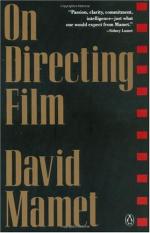
|
| Name: _________________________ | Period: ___________________ |
This test consists of 15 multiple choice questions and 5 short answer questions.
Multiple Choice Questions
1. What is the term which refers to the protagonist's immediate goal?
(a) Superobjective.
(b) Motivation.
(c) Objective.
(d) Obstacle.
2. What does Mamet say most modern art is based around?
(a) Political reasons.
(b) Poetry.
(c) Creativity.
(d) Self-indulgence.
3. What term means a filmmaker, usually a director, who exercises creative control over his or her works and has a strong personal style?
(a) Auteur.
(b) Creator.
(c) Artiste.
(d) Collaborator.
4. Who wrote Memories, Dream, Reflections?
(a) Constantin Stanislavsky.
(b) Bruno Bettelheim.
(c) Sigmund Freud.
(d) Carl Jung.
5. According to Mamet, it is essential to cut that which has what to us?
(a) Deep personal meaning.
(b) Narration.
(c) Explanation.
(d) Emotion.
6. Whose method relies on a succession of images juxtaposed so that the contrast moves the story forward?
(a) Capra.
(b) Eisenstein.
(c) Morrison.
(d) Einstein.
7. What unit does the director want to concern himself with?
(a) The scene.
(b) The beat.
(c) The shot.
(d) The film.
8. Who did Mamet compare with Frank Capra in Chapter 3?
(a) Werner Herzog.
(b) Alfred Hitchcock.
(c) Brad Commers.
(d) David Lynch.
9. All the audience cares about is the what, according to Mamet?
(a) Objective.
(b) Narration.
(c) Protagonist.
(d) Thrust of the scene.
10. What is the term which means "it works correctly on paper but for some reason doesn't work when we get it on its feet"?
(a) The K.I.S.S. Rule.
(b) The Jesus Factor.
(c) The Hippo Factor.
(d) The Rule of Circularity.
11. A good writer only gets better by learning to do what, according to Mamet?
(a) Cut.
(b) Flesh out stories.
(c) Narrate.
(d) Create characters.
12. The smallest unit is the shot; the largest unit is what?
(a) The scene.
(b) The ending.
(c) The beat.
(d) The film.
13. According to Mamet in Chapter 3, "In addition to what you will or not learn about the medium through your desire to understand it, that desire itself will be ______."
(a) Manifested.
(b) Created.
(c) Established.
(d) Attained.
14. Mamet says in Chapter 3 that it is the nature of human perception to go to what?
(a) The protagonist.
(b) The MacGuffin.
(c) The back-story.
(d) The most interesting thing.
15. What craft did Mamet say he does sometimes in Chapter 3?
(a) Paints.
(b) Writes poetry.
(c) Carves wood.
(d) Sculpts.
Short Answer Questions
1. What are after-the-fact attempts to shore up that which was not correctly designed in a film?
2. Chapter 1 deals with what element of the process of directing?
3. What is the term for the thing which stands in the way of the protagonist?
4. Mamet says that the house has to look like a house. The ______ doesn't have to look like a house.
5. What is the rule which Mamet says means "Keep it simple, stupid"?
|
This section contains 417 words (approx. 2 pages at 300 words per page) |

|




